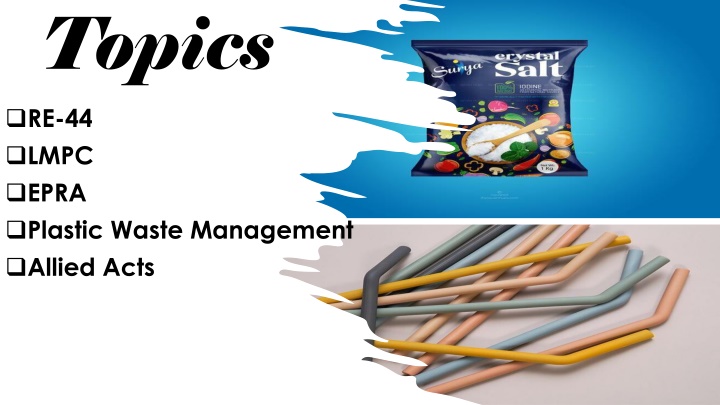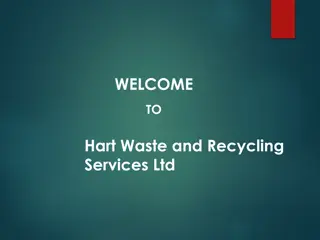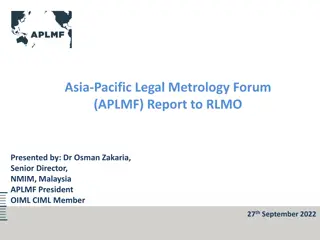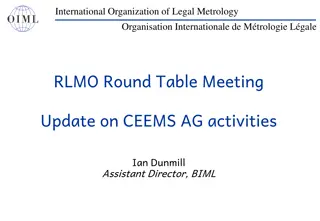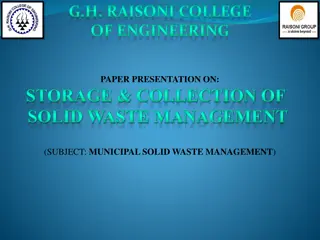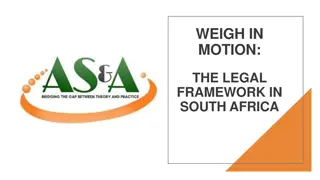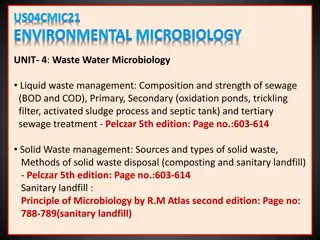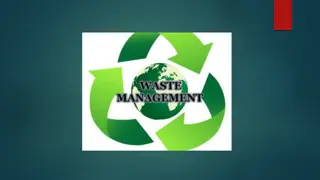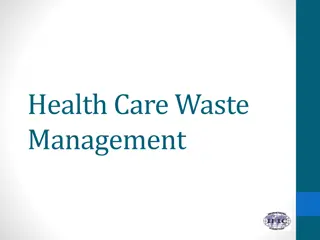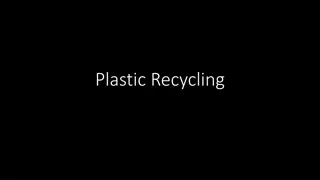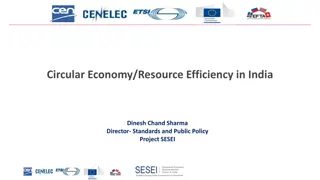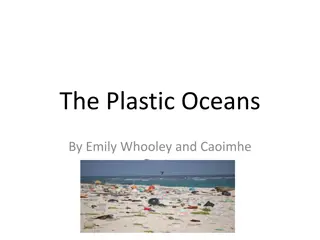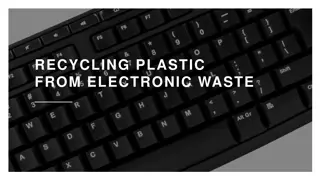Legal Metrology and Plastic Waste Management Regulations in India
Understanding the Legal Metrology (Packaged Commodities) Rules, 2011 in India, which mandate declarations on pre-packaged commodities imported into the country including importer details, net quantity, pricing, and more. Additionally, exploring the definition of pre-packaged commodities and the applicability of these rules to different types of packages. Alongside, delving into the Plastic Waste Management regulations and allied acts governing waste disposal in India.
Download Presentation

Please find below an Image/Link to download the presentation.
The content on the website is provided AS IS for your information and personal use only. It may not be sold, licensed, or shared on other websites without obtaining consent from the author.If you encounter any issues during the download, it is possible that the publisher has removed the file from their server.
You are allowed to download the files provided on this website for personal or commercial use, subject to the condition that they are used lawfully. All files are the property of their respective owners.
The content on the website is provided AS IS for your information and personal use only. It may not be sold, licensed, or shared on other websites without obtaining consent from the author.
E N D
Presentation Transcript
Topics RE-44 LMPC EPRA Plastic Waste Management Allied Acts
RE-44 NOTIFICATION NO. 44 (RE-2000)/1997-2002 NEW DELHI: 24TH NOVEMBER, 2000 . All prepackaged commodities, imported into India, shall in particular carry the following declarations: (a) Name and address of the importer; (b) Generic or common name of the commodity packed; (c) Net quantity in terms of standard unit of weights and measures. If the net quantity in the imported package is given in any other unit, its equivalent in terms of standard units shall be declared by the importer; (d) Month and year of packing in which the commodity is manufactured or packed or imported; (e) Maximum retail sale price at which the commodity in packaged form may be sold to the ultimate consumer. This price shall include all taxes local or otherwise, freight, transport charges, commission payable to dealers and all charges towards advertising, delivery, packing, forwarding and the like as the case may be. Slide-I
RE-44 What is Pre-packaged commodity? Pre-packaged commodity means a commodity which without the purchaser being present is placed in a package of whatever nature, whether sealed or not, so that the product contained therein has a pre- determined quantity. Slide-II Ref: Frequently Asked Questions on the Legal Metrology(Packaged Commodities) Rules, 2011
LMPC The Legal Metrology (Packaged Commodities) Rules, 2011 GSR 202 (E) --- In exercise of the powers conferred by sub-section (1) read with clause (j) and (q) of sub-section (2) of section 52 of the Legal Metrology Act 2009, (1 of 2010), the Central Government hereby makes the following rules, namely The Legal Metrology (Packaged Commodities) Rules, 2011 . Slide-I The said Rules came into force on the 1st day of April, 2011
LMPC What is Legal Metrology? Legal Metrology treats units of weighment and measurement, methods of weighment and measurement and weighing and measuring instruments, in relation to the mandatory technical and legal requirements which have the object of ensuring public guarantee from the point of view of security and accuracy of the weighments and measurements. Slide-II
LMPC Applicability of LMPC The provisions of this Chapter shall not apply to,- (a) packages of commodities containing quantity of more than 25 kg or 25 litre excluding cement and fertilizer sold in bags up to 50 kg; and (b) packaged commodities meant for industrial consumers or institutional consumers. Explanation :- For the purpose of this rule,- i) institutional consumer means the institutional consumer like transportation, Airways, Railways, Hotels, Hospitals or any other service institutions who buy packaged commodities directly from the manufacturer for use by that institution. ii) industrial Consumer means the industrial consumer who buy packaged commodities directly from the manufacturer for use by that industry. Slide-III
LMPC Registration for importer of weight or measure No person shall import any weight or measure unless he is registered with the Director in such manner and on payment of such fees, as may be prescribed. Slide-IV As per Rule 27 of the Legal Metrology (Packaged Commodities) Rules, 2011 time line for registration as manufacturer/ packer/ importer is within ninety days from the date on which he or it commences such pre-packing.
LMPC Penalty for non-registration by importer of weight or measure Whoever imports any weight or measure without being registered under this Act shall be punished with fine which may extend to twenty-five thousand rupees and for the second or subsequent offence, with imprisonment for a term which may extend to six months, or with fine, or with both. Slide-V
LMPC Penalty for import of non- standard weight or measure Whoever imports any non- standard weight or measure shall be punished with fine, which may extend to fifty thousand rupees and for the second or subsequent offence, with imprisonment for a term which may extend to one year and also with fine. Slide-VI
LMPC G.S.R. 577(E) Provision of QR Code In the case of an electronic product which is manufactured or packed or imported after the 15th July, 2022, the package of such product shall, for a period of one year from such date, declare the name of the manufacturer or packer or importer, as the case may be, on the package itself and such declaration shall also inform the consumers to scan the QR code for the following information: Address and other related information Name and number or quantity of each product Size and dimension of the commodity Telephone number and e-mail address in case such, where information is declared through the QR Code and not declared on the package itself; Slide-VII
LMPC Principal display panel In relation to a package, Principal display panel means the total surface area of the package where the information required under these rules are to be given in the following manner, namely; All the information could be grouped together and given at one place; or The pre-printed information could be grouped together and given in one place and online information grouped together in other place; Slide-VIII
EPR Slide-I EPR under E-waste Management Rules, 2016 Section 5 of Chapter II of E-waste Management Rules, 2016 casts certain responsibilities on the producers and mandates certain procedure to be followed including some authorization termed Producer Responsibility Authorization from Central Pollution Control Board (CPCB) when importing the electrical and electronic equipment components, consumables, spares categorized under schedule I of said rules. requirement as of Extended including their and parts
EPR Slide-II Schedule-I
EPR Slide-I EPR under Battery Waste Management Rules, 2022 Section 4(1) of E-waste Management Rules, 2016 casts obligation on the Producer of Extended Producer Responsibility for the Battery that they introduce in the market to ensure the attainment of the recycling or refurbishing obligations. Producer means an entity who engages in: manufacture and sale of Battery including refurbished Battery, including in equipment, under its own brand; or sale of Battery including including in equipment, under its own brand produced by other manufacturers or suppliers; or import of Battery as well as equipment containing Battery; refurbished Battery,
EPR Slide-II Labelling requirements Producers shall ensure that all Battery or Battery packs are appropriately marked with requisite labelling All requisite labels and symbols shall be printed visibly, legibly and indelibly. No person shall place on the market any Battery or Battery pack unless it is marked with the crossed out wheeled bin symbol covering at least 3% of the area of the largest side of the Battery or Battery pack, up to a maximum size of 5 cm x 5 cm). In the case of cylindrical cells, the crossed out wheeled bin symbol shall cover at least 1.5% of the surface area of the Battery or Battery pack, up to a maximum size of 5 cm x 5 cm. Where the size of the Battery or Battery pack is such that the crossed out wheeled bin symbol would be smaller than 0.5 cm x 0.5 cm, the Battery or Battery pack need not be marked but a crossed out wheeled bin symbol measuring at least 1 cm x 1 cm shall be printed on the packaging.
EPR Slide-III Labelling requirements No person shall place on the market a Battery or a button cell containing mercury, cadmium or lead unless it is marked with the respective chemical symbol Hg ; Cd or Pb . The symbol of the heavy metal shall, be printed beneath the symbol shown in Figure I; and cover an area of at least one-quarter the size of the crossed out wheeled bin symbol as indicated below:
PWM Plastic Waste Management Rules, 2016 In exercise of the powers conferred by sections 6, 8 and 25 of the Environment (Protection) Act, 1986 (29 of 1986) the Plastic Waste Management Rules have been published from time to time. The PWM Rules, 2016 cast Extended Producer Responsibility (EPR) on Producer, Importer, and Brand Owner. EPR is applicable to both pre-consumer and post-consumer waste. Slide-I plastic packaging
PWM EPR under Plastic Waste Management Rules, 2016 Extended producer s responsibility means the responsibility of a producer, Importer, and Brand Owner for the environmentally sound management of the product until the end of its life. The PWM Rules, 2016 cast Extended Producer Responsibility (EPR) on Producer, Importer, and Brand Owner and EPR shall be applicable to both pre-consumer and post-consumer plastic packaging waste. Slide-II
PWM Obligated Entities to EPR Producer (P) of plastic packaging; Importer (I) of all imported plastic packaging and / or plastic packaging of imported products; Brand Owners (BO) including online platforms/marketplaces supermarkets/retail chains other than those, which are micro and small enterprises as per the criteria of Ministry of Micro, Small and Medium Enterprises, Government of India Plastic Waste Processors (PWPs) except cement kilns & road construction Slide-II and
PWM Plastic packaging categories covered under EPR The following plastic packaging categories are covered under EPR: Category I : Rigid plastic packaging Category II : Flexible plastic packaging of single layer or multilayer (more than one layer with different types of plastic), plastic sheets or like and covers made of plastic sheet, carry bags, plastic sachet or pouches Category III : Multilayered plastic packaging (at least one layer of plastic and at least one layer of material other than plastic) Category IV : Plastic sheet or like used for packaging as well as carry bags made of compostable plastics. Eg. Polylactic acid, also known as PLA. Slide-III
PWM Marking or labelling Each plastic carry bag and multilayered packaging shall have the following information printed in English namely,- Name, registration number of the manufacturer and thickness in case of carry bag; Name and registration number of the manufacturer in case of multilayered packaging; and Name and certificate number [Rule 4(h)] in case of carry bags made from compostable plastic Slide-IV
PWM Marking or labelling Each recycled carry bag shall bear a label or a mark recycled as shown below and shall conform to the Indian Standard: IS 14534: 1998 titled as Guidelines for Recycling of Plastics , as amended from time to time; Slide-V
PWM Single Use Plastic The following identified single use plastic items, which have low utility and high littering potential, have been prohibited, with effect from 1st July, 2022, vide Plastic Waste Management Amendment Rules, 2021: Ear buds with plastic sticks, plastic sticks for balloons, plastic flags, candy sticks, ice- cream sticks, polystyrene [Thermocol] for decoration; Plates, cups, glasses, cutlery such as forks, spoons, knives, straw, trays, wrapping or packing films around sweet boxes, invitation cards, and cigarette packets, plastic or PVC banners less than 100 micron, stirrers. The notification also prohibits manufacture, import, stocking, distribution, sale and use of plastic carry bags having thickness less than 120 microns with effect from 31st December, 2022 Slide-V
Allied Acts Allied Acts Apart for collection of duty, Customs has also been entrusted with the responsibility to ensure compliance with prohibitions or restrictions imposed on the import and export of goods under the Foreign Trade Policy (FTP) and other Allied Acts. The Customs has a pivotal role to play because, it is the agency stationed at the border to enforce the rules, regulations and orders issued by various administrative Ministries. Slide-I
Allied Acts For instance, import and export of specific goods may be restricted/prohibited under other laws such as Environment Protection Act, Wild Life Act, Indian Trade and Merchandise Marks Act, Arms Act, etc. and these will apply to the penal provisions of the Customs Act, 1962 rendering such goods liable to confiscation under Sections 111(d) for Import Section 113(d) for Export Slide-II
Allied Acts List of Allied Acts Prevention of Food Adulteration Act, 1954 Food Safety and Standards Act, 2006 Drugs and Cosmetics Act, 1940 Livestock Importation Act, 1898 Destructive Insects & Pests (DIP) Act, 1914 Legal Metrology Act, 2009 Narcotic Drugs and Psychotropic Substances Act, 1985 Prevention of Money Laundering Act, 2002 Environment (Protection) Act, 1986 Foreign Exchange Management Act 2000 Indian Evidence Act, 1872 Indian Penal Code, 1860 Code of Criminal Procedure, 1973 . Slide-III
Allied Acts Single Window Interface for Facilitating Trade (SWIFT) The Ministry w.e.f. 01.04.2016 introduced the SWIFT which has brought speedy and accurate functioning as being having the interface with different PGA (Participating Govt. Agencies) dealing with allied acts. Agencies under the umbrella of SWIFT Food Safety standard authority of India (FSSAI). Directorate of Plant Protection, Quarantine & Storage (DPPQ&S) Drug Controller (CDSCO) Animal Quarantine (AQCS) Wild Life Crime Control Bureau (WCCB) Slide-IV
Allied Acts IPC(Few relevant Sections) Section 180-Refusing to sign a statement Whoever refuses to sign any statement made by him, when required to sign that statement by a public servant legally competent to require that he shall sign that statement, shall be punished with simple imprisonment for a term which may extend to three months, or with fine which may extend to five hundred rupees, or with both. Slide-IV Section 186-Obstructing public servant in discharge of public function Whoever voluntarily obstructs any public servant in the discharge of his public functions, shall be punished with imprisonment of either description for a term which may extend to three months, or with fine which may extend to five hundred rupees, or with both. Section 187-Omission to assist public servant when bound by law to give assistance Whoever, being bound by law to render or furnish assistance to any public servant in the execution of his public duty, intentionally omits to give such assistance, shall be punished with simple imprisonment for a term which may extend to one month, or with fine which may extend to two hundred rupees, or with both
Allied Acts IPC(Few relevant Sections) Section 193-Punishment for false evidence Whoever intentionally gives false evidence in any of a judicial proceeding, or fabricates false evidence for the purpose of being used in any stage of a judicial proceeding, shall be punished with imprisonment of either description for a term which may extend to seven years, and shall also be liable to fine; and whoever intentionally gives or fabricates false evidence in any other case, shall be punished with imprisonment of either description for a term which may extend to three years, and shall also be liable to fine. Slide-IV Section 228-Intentional insult or interruption to public servant sitting in judicial proceedings Whoever intentionally offers any insult, or causes any interruption to any public servant, while such public servant is sitting in any stage of a judicial proceeding, shall be punished with simple imprisonment for a term which may extend to six months, or with fine which may extend to one thousand rupees, or with both.
Thank you Kuldeep Vishwabandhu kuldeepvishwabandhu@gmail.com 9278624239
